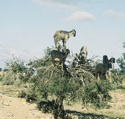|
Thank you for this insightful post. These are good things to keep in mind when making maps... or any kind of colour-coded diagram, really.
|
|
|
|

|
| # ? Jun 7, 2024 17:39 |
|
If you are gonna go with a two colour scale red-green is basically the worst possible choice thanks to the prevalence of red-green colour blindness.
|
|
|
|
This is my go-to color picker site: http://colorbrewer2.org/ Has the terribleness of the spectral/rainbow ROYGBIV color scale been discussed yet? Because it's terrible.
|
|
|
|
Honj Steak posted:This is extremely fascinating but equally depressing. Why can't we leave these people in peace? If we're talking about the Amazon, mostly because the forests where the uncontacted people live are simply being cut down, both by Big Corporations and, to a surprisingly large degree, by nearby villagers. Including "protected" forests. A friend of mine is just returning from an expedition and "old" forests that were there in satellite images taken two years ago do not exist anymore.
|
|
|
|
Maybe they're gonna make more with all that wood they cut down.
|
|
|
|
Patter Song posted:Palestine turned into a heavily Christianized region after Constantine and Helena had their way with it and Jerusalem became one of the biggest centers of Christianity in the 5th-6th centuries, and after the massacre of the Jews of Palestine in the early 7th century for siding with the Sassanids against the Eastern Roman Empire the Jewish community in Palestine was pretty small by the time of the Arab conquests. Most of the early converts to Islam after the Arab conquests were various heretical Christians (Monophysites, Nestorians, etc.) who had no real loyalty to their former authorities in Constantinople, not Jews. Wouldn't it also be possible that a significant proportion of the Jewish population converted to Christianity between the 2nd and 7th century? That hypothesis has the added merit of accounting for genetic testing that indicated substantial similarities between Jewish and Palestinian Arab populations.
|
|
|
|
EvanSchenck posted:Wouldn't it also be possible that a significant proportion of the Jewish population converted to Christianity between the 2nd and 7th century? That hypothesis has the added merit of accounting for genetic testing that indicated substantial similarities between Jewish and Palestinian Arab populations. That's probably the case, although the notion of conversion is a bit anachronistic during the period. After the destruction of the Temple, the rabbinic movement begins to emerge as the guiding force in the Jewish world, but only slowly. Most Jewish communities, especially earlier in that time frame, aren't "rabbinic" and aren't properly Jewish in the eyes of the Rabbis. They thought of themselves as Jewish, of course. What happens is that a relatively fluid and diverse set of Jewish communities becomes increasingly formalized and divided between the models provided by the Christian bishops and the Rabbis, who are often complicit in drawing boundaries where they didn't previously exist in a strong fashion. (A ludicrous and non-charged example: if the rabbis in a given area proclaim that blue hats are forbidden, it's not uncommon that the local bishops will declare blue hats mandatory. This because it seems like the communities on the ground didn't really respect the difference. There's more than one exasperated bishop who has to tell his congregation on sunday morning that they really shouldn't have been at the synagogue last night.)
|
|
|
|
Yall remember this map? Well I got to wondering how far this concept could be pushed. Just how small an area could you squish the earths population? Wikipedia tells me the most densely populated neighborhood still in existence is a neighborhood in Dhaka, Bangladesh, with a population density of around 440k people per square mile. But thats neighborhoods that still exist, right? What about neighborhoods that don't? Enter Kowloon Walled City.  Kowloon Walled City was bulldozed in the 90's for being a blight on the collective soul of humanity. But in its glorious prime it had a population of 50k damned souls, living in homes that could be as luxuriously huge as 20 square meters(if you were a Triad crime boss). In addition it featured numerous factories, shops, medical clinics, casinos, and brothels for its populace to make their living in. The city had a firmly established area of .01 square miles, with no fuzzy boundaries. Just look at it.  Its like God dropped one of his Legos. But that gives old Kowloon a population density of 5 million human beings per square mile. TAKE THAT Dhaka! So how big would this theoretical dystopian nightmare city of 7 billion be? About 1400 sq miles. Or the size of Hartley County Texas.  If you expanded this city to cover the whole world 40k style it'd be almost exactly one quadrillion people, considerably larger than the numbers most scifi writers use for their world spanning cities. Star Wars Coruscant has a population of a trillion, for example. 40k itself, with cities the size of continents that extend hundreds of miles into the sky caps out at a few hundred billion. Scifi writers have always lacked a proper sense of scale. Schizotek fucked around with this message at 20:25 on Aug 5, 2014 |
|
|
|
How did the destruction of Kowloon go over with its inhabitants?
|
|
|
|
Its Hong Kong. I have serious doubts anybody bothered to check. But as hellish as it was, most of the City's inhabitants lived there completely by choice. There were, and are, far worse ways to live in Hong Kong. Like in dog cages stacked floor to ceiling in a basement. So they were probably not terribly happy.
|
|
|
|
quote:The government spent around 2.7 billion Hong Kong dollars in compensation to the estimated 33,000 families and businesses. Some were not satisfied and tried to stop the evacuations And a dude went in and took a bunch of photographs once, you can see them here.  It's clearly not a nice place to live but it doesn't look as completely hellish as you'd expect, I always thought it was really interesting.
|
|
|
|
Koramei posted:No clue how much a HK dollar is but at least they cared a tiny bit. It's just under $7k USD per person in today's money, and the exchange rate's been pretty solid for a while so I think that's accurate.
|
|
|
|
http://www.kowloonwalledcity.org/Kowloon-Walled-City-Map.html URL that contains a huge map of the place. I tried to upload the map to imgur but it shrunk it down to like 900xsomething.
|
|
|
|
There's also a reasonably well done documentary on youtube that gives a pretty good idea of what life was like there. https://www.youtube.com/watch?v=Lby9P3ms11w So not soul crushingly terrible. Especially by the standards of non-western countries.
|
|
|
|
Schizotek posted:There's also a reasonably well done documentary on youtube that gives a pretty good idea of what life was like there. The rats, roaches, torrential leaks, and open sewers would suggest that it wasn't necessarily a good place to live, though...
|
|
|
|
Hedera Helix posted:The rats, roaches, torrential leaks, and open sewers would suggest that it wasn't necessarily a good place to live, though... Eh, as a Florida native I can say you get used to all four of those pretty easily. Besides, the roach infested food was for rich people outside the City. The actually Kowloonians ate fresh most of the time according to the video. Benefits of living right next to the harbor I suppose. But yeah, that place wasn't in the top 100 lists of places to live for anyone.
|
|
|
|
But can you even imagine the fire, electrical, toxic pollutant/carcinogen, and earthquake danger?
|
|
|
|
With a little more code enforcement and a little less poverty it could have been a pretty rad and livable place by most standards.
|
|
|
|
Baronjutter posted:With a little more code enforcement and a little less poverty it could have been a pretty rad and livable place by most standards. Yes. It would have been a standard apartment tower. 
|
|
|
|
DuckHuntDog posted:Aren't a number of the uncontacted tribes in Brazil remnants of collapsed civilizations? No, they were mostly to the east and northeast. Not a ton is known about the Amazonian Basin civilization or civiliations except that a missionary saw it and described it in the 1500s and that it was gone completely and the people were nomadic or semi nomadic 40 years later and no cities were found. The tribes that are descended from the civilization have remnant features such as hereditary nobility, grain storage that can last for years, building setups that would allow for a far larger population than can be supported by the semi-nomadic hunting, fish farms, clearings between buildings in the villages that allow for wide roads, etc.. There are a whole bunch of tribes in the Amazonian Basin where their culture doesn't make sense for a tribe that has lived as they do forever and they have weird cultural traditions that only make sense if they were once part of a civilization and continued what traditions they were capable of continuing as the civilization collapsed. The location of the Amazonian Basin civilization region is only known by the presence of various geoglyphs and Terra preta. There's satellite imagery that shows where there were likely cities, and people have found a lot of archaeological evidence now but it took a while. The current uncontacted Brazilian tribes are likely not descended from the Amazon Basin civilization, though. edit: http://www.gerhardbechtold.com/TP/BrazilTP3.php map of terra preta sites, the uncontacted tribes are mostly on the border between Brazil and Peru, southwest of terra preta regions. fermun fucked around with this message at 04:06 on Aug 6, 2014 |
|
|
|
DrSunshine posted:But can you even imagine the fire, electrical, toxic pollutant/carcinogen, and earthquake danger? Well, it sounds like every inch of the city is wet and damp, year-round, thanks to how difficult it is for rain to work its way down through everything. So fires probably weren't too big of a threat. An earthquake, on the other hand...
|
|
|
|
Schizotek posted:If you expanded this city to cover the whole world 40k style it'd be almost exactly one quadrillion people, considerably larger than the numbers most scifi writers use for their world spanning cities. Star Wars Coruscant has a population of a trillion, for example. 40k itself, with cities the size of continents that extend hundreds of miles into the sky caps out at a few hundred billion. Scifi writers have always lacked a proper sense of scale. As interesting as a hypothetical as this is, I don't think Kowloon is really scalable. Kowloon was able to achieve such high population density because it was primary used as residential space. It contained little infrastructure required to maintain a larger population, such as roads, utility providers, factories, schools, hospitals, etc. These were all located in other parts of Hong Kong. If Kowloon had been an island onto itself, it wouldn't have been sustainable.
|
|
|
|
Mu Cow posted:As interesting as a hypothetical as this is, I don't think Kowloon is really scalable. Kowloon was able to achieve such high population density because it was primary used as residential space. It contained little infrastructure required to maintain a larger population, such as roads, utility providers, factories, schools, hospitals, etc. These were all located in other parts of Hong Kong. If Kowloon had been an island onto itself, it wouldn't have been sustainable. Put it above or below the infrastructure. It's short enough that it leaves plenty of vertical space for other things.
|
|
|
|
Ditocoaf posted:An earthquake, on the other hand... Hong Kong isn't anywhere near seismically active areas. We don't get earthquakes here. The only disasters that hit Hong Kong with any frequency are typhoons. Mu Cow posted:As interesting as a hypothetical as this is, I don't think Kowloon is really scalable. Kowloon was able to achieve such high population density because it was primary used as residential space. It contained little infrastructure required to maintain a larger population, such as roads, utility providers, factories, schools, hospitals, etc. These were all located in other parts of Hong Kong. If Kowloon had been an island onto itself, it wouldn't have been sustainable. By the way, Kowloon is a peninsula that still exists (I should know, I lived there until 2012). In fact, it's expanded a lot because the government keeps reclaiming land. The very specific area that you guys are talking about is the Kowloon Walled City, which was a tiny plot of land not ceded by Qing China to the British during one of the unequal treaties of the 19th century. It was then not picked up by the People's Republic after the second revolution, which is why it became a (literally, police were not allowed to go there) lawless IRL Shadowrun setting long before there was ever a Shadowrun. Nowadays, the Walled City is a nice park and Kwun Tong has taken over the most densely populated jurisdiction title at something like 57k/km2. Although I think the most densely populated arbitrary place in HK is the little island of Ap Lei Chau, which has a bunch of public housing towers that bring it to 66k/km2.  The Walled City was in district 10 there, labeled Kowloon City. More specifically, it was right above that bit jutting into the bay. That's the old Kai Tak airport runway. It's now a cruise terminal that cost untold amounts of government money and now sees like one cruise ship every two weeks. It makes me mad. I live comfortably in suburban Sha Tin district. Number 5 there. Check out our low population density. I got a whole 700 square feet to myself.
|
|
|
|
Schizotek posted:If you expanded this city to cover the whole world 40k style it'd be almost exactly one quadrillion people, considerably larger than the numbers most scifi writers use for their world spanning cities. Star Wars Coruscant has a population of a trillion, for example. 40k itself, with cities the size of continents that extend hundreds of miles into the sky caps out at a few hundred billion. Scifi writers have always lacked a proper sense of scale. And then everybody would starve from the lack of farmland, yes. Stand on Zanzibar (1968) predicted that in 2010 there would be 7 billion people in the world, and if they could all stand next to each other, they'd fill Zanzibar. The end of the novel is an image of more and more people gradually being edged into the ocean.
|
|
|
|
Schizotek posted:If you expanded this city to cover the whole world 40k style it'd be almost exactly one quadrillion people, considerably larger than the numbers most scifi writers use for their world spanning cities. Star Wars Coruscant has a population of a trillion, for example. 40k itself, with cities the size of continents that extend hundreds of miles into the sky caps out at a few hundred billion. Scifi writers have always lacked a proper sense of scale. Even that estimate is too low, cause Kowloon is only a dozen or two stories high right? So triple or even quintuple that density for when your going into proper sky scraper territory.
|
|
|
|
House Louse posted:The end of the novel is an image of more and more people gradually being edged into the ocean. Haha it's funny because global warming!
|
|
|
|
The problem with super high populations isn't the space to put them, but providing both the energy they consume and getting rid of the waste heat. A quadrillion people each exhaling a dozen liters of body temperature air every minute and burning a couple of thousand of calories a day would make the planet uninhabitable. Maybe if we moved the Earth out to a more distant orbit we could handle a trillion...
|
|
|
|
ClearAirTurbulence posted:The problem with super high populations isn't the space to put them, but providing both the energy they consume and getting rid of the waste heat. A quadrillion people each exhaling a dozen liters of body temperature air every minute and burning a couple of thousand of calories a day would make the planet uninhabitable. Maybe if we moved the Earth out to a more distant orbit we could handle a trillion...
|
|
|
|
Yet one more reason to live in space instead.
|
|
|
|
Of course, most demographic trends suggest that the population will stabilize around 9-10 billion or so, so we don't have much to worry about on that front. Much more relevant is the consumption per-capita -- we need to find a way to support that number living at a fairly decent standard that can be sustained within the planet's ecosystem.
|
|
|
|
DrSunshine posted:Of course, most demographic trends suggest that the population will stabilize around 9-10 billion or so, so we don't have much to worry about on that front. Much more relevant is the consumption per-capita -- we need to find a way to support that number living at a fairly decent standard that can be sustained within the planet's ecosystem.
|
|
|
|
Muscle Tracer posted:Yet one more reason to live in space instead. Space: where heat dissipation is easy.
|
|
|
|
ClearAirTurbulence posted:Put it above or below the infrastructure. It's short enough that it leaves plenty of vertical space for other things. 
|
|
|
|
Communist Zombie posted:Even that estimate is too low, cause Kowloon is only a dozen or two stories high right? So triple or even quintuple that density for when your going into proper sky scraper territory. The tallest building in Kowloon is The International Commerce Center. It has 118 floors and tops out at about 1600 feet. It's also home to some of the tallest residential buildings in the world and has the highest skyscraper density in the world. Pictured: Kowloon being more like 10 dozen stories high. 
|
|
|
|
Bloodnose posted:The tallest building in Kowloon is The International Commerce Center. It has 118 floors and tops out at about 1600 feet. I meant the Kowloon walled city sorry. Unless the new area has density equal to the old walled city.
|
|
|
|
A Buttery Pastry posted:Assuming that 400X number is right, the hard limit would then be about 70 times the current US per capita energy use I think. Of course making that energy sustainable is another matter entirely, but at least it sounds like a pretty decent standard of living would be possible given the right technology. That's just the maximum for heat dissipation. It doesn't mean we can actually find enough usable energy resources to produce that kind of heat/standard of living, and more importantly it ignores the environmental consequences of using that energy. I'm pretty sure there's barely enough energy around to support 10 billion people with a current American standard of living and energy efficiency, much less to do it without turning the planet into a toxic waste dump at the same time.
|
|
|
|
icantfindaname posted:That's just the maximum for heat dissipation. It doesn't mean we can actually find enough usable energy resources to produce that kind of heat/standard of living, and more importantly it ignores the environmental consequences of using that energy. I'm pretty sure there's barely enough energy around to support 10 billion people with a current American standard of living and energy efficiency, much less to do it without turning the planet into a toxic waste dump at the same time.
|
|
|
|
PittTheElder posted:Space: where heat dissipation is easy. Space: where Earth, renowned for never having had an ice age even once, is located. Earth: renowned for the ease with which its climate can be controlled, unlike man-made structures. Muscle Tracer fucked around with this message at 03:28 on Aug 8, 2014 |
|
|
|

|
| # ? Jun 7, 2024 17:39 |
|
With populations that high the volume of food needed gets unmanageable even when you consider possibilities like genetically engineered foodstuffs that can digest rock. I think to get to the trillions we'll need to give up chemical fuel as the primary source of energy for humans. We can have nanobots synthesize fuel for our cells out of the waste, and they can get the energy to do this from nuclear power. Who knows, maybe we'll even have practical fusion power by then but I doubt it. That way you can have a trillion people without having to produce a billion tons of food every day.
|
|
|


































